With the City Championships over, most players will be turning their attention to the next Pro Circuit and the upcoming $10Ks. That change in focus will no doubt be followed by a change in preferred formats. Personally, I have been interested in Modern Age since Pro Circuit Sydney; with my move and everything else, I had little time to prepare for the City Championships, let alone play in them. Thus, instead of spending time trying to develop a Silver Age strategy, I have been working hard with the Marvel Team-Up set, trying to see what new decks it could potentially spawn.
After my last article, however, I wanted to talk about the Marvel Team-Up set in a much broader sense. We have been without Sealed / Draft reviews since Heralds of Galactus, so I wanted to start writing a series devoted to the Sealed / Draft aspect of Marvel Team-Up. While I am no Alex Brown or Adam Prosak, I have managed to string together several strong Day 2 performances and consistently place well in premier-level Sealed tournaments. Still, my biggest selling point could be that I will be writing from your perspective. I am not a Sealed guru. I get my information the same way that you do: drafts with fellow players. Instead of being able to give you statistical probabilities or some other manner of analysis that seems detached and impersonal, I can give you real-life examples of what has worked for me and—arguably more importantly—what hasn’t. In this manner, both you and I will learn a lot about the Marvel Team-Up set and, in the process, become better Sealed players overall.
The Beginning
After spending some time and consideration on this topic, I felt that the best way to approach things would be by taking the teams one at a time and detailing the different options they have at each point on the resource curve. I want to begin with the Marvel Defenders, as they have gotten a lot of buzz not only as a strong Sealed / Draft team, but also as a potential threat in the Modern Age environment. Hopefully, with a detailed discussion of the available options, strategies and archetypes could become a little bit clearer.
1-drops
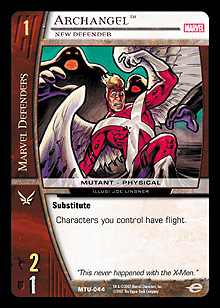 Archangel, New Defender—Global modifiers are always a good thing. When they have no real restrictions, their utility goes up even further. Add to that the relatively new substitute keyword, and you have a definite winning combination. You might think that with all of those strengths, the stats on this particular character would be subpar, but at 2 ATK / 1 DEF, he is a rather respectable size. Archangel provides you with more than you could ever expect out of a single 1-drop. If I am trying to go Marvel Defenders, I will always look for this guy.
Archangel, New Defender—Global modifiers are always a good thing. When they have no real restrictions, their utility goes up even further. Add to that the relatively new substitute keyword, and you have a definite winning combination. You might think that with all of those strengths, the stats on this particular character would be subpar, but at 2 ATK / 1 DEF, he is a rather respectable size. Archangel provides you with more than you could ever expect out of a single 1-drop. If I am trying to go Marvel Defenders, I will always look for this guy.
Iceman, New Defender—You know how I just talked up Archangel and said that he had no drawbacks? Well, I think that Iceman took them from him. Iceman has a power that I don’t think is that great—which, incidentally, is stamped with backup—and has a pretty poor body at 1 ATK / 2 DEF. I don’t really see a situation where I would play Iceman in Sealed or Draft, save maybe in an off-curve deck where I was desperate for a 1-drop. I may be off base, but I prefer my 1-drops to be aggressive and perform noteworthy functions. Iceman will only provide a benefit if your opponent decides to exhaust the character that he targeted, which will not always happen. Sadly, I just don’t see this guy getting played.
Howard the Duck, Master of Quack-Fu—We all know that Howard the Duck is the man, and apparently so did UDE when they gave him the body of a 2-drop for the cost of a 1-drop. His power is actually pretty interesting, as you can keep him around for a while, and in the later turns, he can essentially turn into a +2 ATK modifier. In that same vein, though, if your opponent can get into the hidden area, Howard might turn into a liability and cost you a nice chunk of endurance. Overall, I could see playing him, especially if I am short on 2-drops.
Wong, Mystical Manservant—I am not really that excited about this guy. Thankfully, UDE realized that Wong’s application is likely to be limited to Constructed play and made him a rare. That being said, if you open Wong, you will undoubtedly want to pass him—and maybe even ship him by on the wheel—as I don’t see a person spending even an 8th pick on him. Overall, Wong is just not a very playable Sealed / Draft card.
2-drops
Beast, New Defender—Another character with subpar stats, but that is to be expected when the character has backup. The real reason I am not a big fan of Beast is that his backup is too easy to get around. It does get better the longer you have him on the board, which is why he also has the evasion keyword (each time you use his power, you are essentially forcing either a team attack or a pump from your opponent), but I am still not a big fan. Overall, he is not the worst inclusion in a deck, but I probably would take someone else over him, especially considering the good options at 2 that the Marvel Defenders provide.
Tania Belinskya ◊ Red Guardian—With a 1 ATK / 4 DEF body, Tania is not very imposing, but no one who can give a Mega-Blast to a character every turn should be expected to have the best stats in the world. Her big DEF allows you to suffer minimal endurance loss the first few turns, which in turn allows you to maximize her  backup. The substitute mechanic allows you to get a +4 ATK modifier in a pinch if you need that little extra damage to finish things off. I really like her in Draft and consider her a strong mid-range pick.
backup. The substitute mechanic allows you to get a +4 ATK modifier in a pinch if you need that little extra damage to finish things off. I really like her in Draft and consider her a strong mid-range pick.
Jack of Hearts—A 2 ATK / 2 DEF 2-drop—even one with flight and range—is not generally a playable card, but if you can find a way to exhaust Jack, he becomes far more formidable. Given that the Marvel Defenders have a plethora of cards that allow you to exhaust a character, Jack is a character that I always look for when I am drafting Marvel Defenders.
John Walker ◊ U.S. Agent—Here we have a character with solid stats and a relevant backup power. Since he’s 3 ATK / 3 DEF, there are many lower-drop characters that will be unable to force the stun without the aid of an ATK modifier, which means that you are forcing your opponent to overextend just to get through a 2-drop. His backup is also pretty solid, especially if you are forced to play an off-team character. Much like Jack of Hearts, U.S. Agent is a 2-drop I actively seek when I am drafting Marvel Defenders.
3-drops
Hellcat—Hellcat is another character with a strong backup power. Since she is concealed, her backup power becomes more useful and can even force a two-for-one if you are lucky. I don’t really consider her mediocre DEF to be too large an issue due to her concealment in the hidden area. Overall, she is a reasonable character, and you shouldn’t be unhappy if you are playing her in your decks.
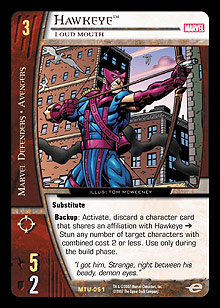 Hawkeye, Loud Mouth—This guy can be an absolute bomb or an absolute dud; it just depends on your matchups. Against an off-curve deck, he can single-handedly win you games, but in a normal curve match, he is really a mediocre play. He isn’t awful on turn 3, as he generally can force your opponent to lose a character while you maintain your board. He really starts to be a liability after that turn, though, as his activated power loses a lot of utility. If you get him, I would consider playing him, but try to make sure your other 3-drop options have substitute so that you can have an answer if his low DEF becomes problematic.
Hawkeye, Loud Mouth—This guy can be an absolute bomb or an absolute dud; it just depends on your matchups. Against an off-curve deck, he can single-handedly win you games, but in a normal curve match, he is really a mediocre play. He isn’t awful on turn 3, as he generally can force your opponent to lose a character while you maintain your board. He really starts to be a liability after that turn, though, as his activated power loses a lot of utility. If you get him, I would consider playing him, but try to make sure your other 3-drop options have substitute so that you can have an answer if his low DEF becomes problematic.
Sub-Mariner, King of Atlantis—Speaking of substitute, Sub-Mariner provides that along with a solid body, albeit with a slight drawback. I actually like cards that are strong but have little drawbacks like this, as a good player can always make those “drawbacks” disappear. It is a little frustrating that by playing him you are advertising that he will be your last attacker, especially if you are going up the curve with him (which tells your opponent that you have attack modifiers to use on him). Still, he is a solid option that should see a lot of play.
Kyle Richmond ◊ Nighthawk—I really like this guy. Secret Defenders is one of my favorite cards in the game, and Kyle can fetch it for you without the cost of a card from your hand. His stats are nothing to get excited about, but they are not bad either. With an average body and a good power, Kyle should see a lot of play in mono-team builds as well as team-up decks.
4-drops
Richard Rider ◊ Nova—I seriously dislike this guy. I have heard others rave about his power, but I think that is ludicrous. If you use his backup power and target one of your opponent’s characters, the smart opponent would propose an attack by the targeted character that will result in a stunback, thus negating the exhaustion that 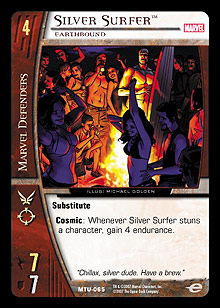 you paid during the build phase. Add in an average body (7 ATK / 7 DEF) and you have a character that I would only play if I was terribly short on 4-drops.
you paid during the build phase. Add in an average body (7 ATK / 7 DEF) and you have a character that I would only play if I was terribly short on 4-drops.
Silver Surfer, Earthbound—Silver Surfer’s power is quite good. Unfortunately, it's cosmic, so it is immediately negated when he becomes stunned. This is further complicated with by low DEF. I would still play him over Richard Rider ◊ Nova, but I am not a big fan here either.
Johnny Blaze ◊ Ghost Rider—We are back to backup characters with subpar stats; Johnny Blaze weighs in at an unimpressive 8 ATK / 6 DEF. At first glance, this might be another character that you immediately would throw into the filler department, but I honestly think that he is an acceptable last-spot filler in your curve. His backup power works well with his low DEF—even though his low DEF all but ensures he will stun, that is generally what you want out of him. In the end, it's not a bad idea to play him; it just means that you are more susceptible to attacks up the curve.
Gargoyle—I really like this guy. His base stats are less than impressive, but his backup power will often allow you to maintain board presence. All told, Gargoyle is the Marvel Defenders 4-drop that I value most.
Samantha Parrington ◊ Valkyrie—I remember thinking that Blob, Fred Dukes had bad stats. That was until I saw Samantha. At 5 ATK / 9 DEF, she may be one of the most underwhelming characters you could play on turn 4 in Sealed. Thankfully, her power more than makes up for her low-ATK stature. If you happen to have the initiative on turn 5 , you could conceivably swing down the curve with your 5-drop and then swing across it, forcing your opponent to lose board presence while you maintain your own. Sadly, Samantha is a rare, but I will definitely play her if I manage to get her.
5-drops
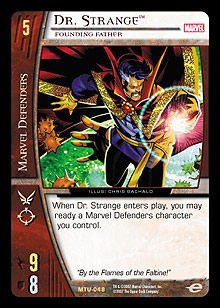 Dr. Strange, Founding Father—This is another card that will have more application in Constructed than Sealed or Draft. He has mediocre stats, but his power is pretty solid, allowing you to get the most out of your backup powers. Unfortunately, pulling off a good backup power followed by Dr. Strange isn’t that likely in Sealed or Draft, but if you are fortunate enough to get it off, more power to you.
Dr. Strange, Founding Father—This is another card that will have more application in Constructed than Sealed or Draft. He has mediocre stats, but his power is pretty solid, allowing you to get the most out of your backup powers. Unfortunately, pulling off a good backup power followed by Dr. Strange isn’t that likely in Sealed or Draft, but if you are fortunate enough to get it off, more power to you.
Hulk, Grumpy Green Goliath—Now here is a staple for any Marvel Defenders deck! He is essentially a 10 ATK / 10 DEF, because no matter who has the initiative, you should have access to a way to exhaust him. If you happen to have some of the support cards that let you ready an exhausted defender, he could become a really difficult character for your opponent to deal with.
Brunnhilde ◊ Valkyrie—While not quite as good as the Grumpy Green Goliath, Brunnhilde is more than serviceable as a 5-drop. Remember earlier when I said global modifiers are a good thing? That rule holds true here as well. She becomes a real thorn in the side of your opponents if you can use defensive tricks to keep her around, and if you attack with her last, you can likely get the benefit of her invulnerability. Overall, Brunnhilde is a strong character that warrants inclusion in a lot of decks.
Devil-Slayer—I would be remiss if I didn’t mention that this guy has some fun combos that you can pull off in Constructed, but I am just underwhelmed with his power in a Sealed environment. Generally, plot twists are at a premium in Sealed and Draft, and you need to use them at opportune moments to get the most out of them. With Devil-Slayer’s power, you lose that ability to surprise your opponent, and you will often be unable to use those plot twists when it is most advantageous to you (generally at a time when they would come as a surprise or allow you to make an attack or play that you normally couldn’t). I have seen him played in Sealed, but I wouldn’t take my chances on playing him. If he has worked out for you, send me a story and maybe I will talk a little bit more about it!
6-drops
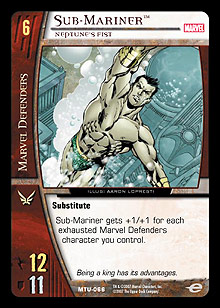 Sub-Mariner, Neptune’s Fist—This Sub-Mariner is hands down the best 6-drop available for Marvel Defenders. The more characters you have hanging around, the more problematic Sub-Mariner will be for your opponent. With the plethora of exhaustion effects available to the Marvel Defenders, he is almost assured to be +2 ATK / +2 DEF when he attacks or is attacked into. I love characters that can potentially swing up the curve with no help, and Namor does it best.
Sub-Mariner, Neptune’s Fist—This Sub-Mariner is hands down the best 6-drop available for Marvel Defenders. The more characters you have hanging around, the more problematic Sub-Mariner will be for your opponent. With the plethora of exhaustion effects available to the Marvel Defenders, he is almost assured to be +2 ATK / +2 DEF when he attacks or is attacked into. I love characters that can potentially swing up the curve with no help, and Namor does it best.
Silver Surfer, Prodigal Herald—Surfer is by no means bad, but compared to Sub-Mariner, he loses a certain something. There is also another Surfer at 4, so playing the 6-drop too and depending on it as your only play could be risky if you have both. Granted, access to power-ups can be game-changing—especially in Sealed or Draft—but I’m not sure that is enough to compensate for the risk of having a redundant drop on turn 6. Add in the drawback of having to attack with him last, and I am really loath to play him, even in spite of his decent cosmic power. I guess Sub-Mariner, Neptune’s Fist spoiled me!
Wendell Vaughn ◊ Quasar—At this point on the curve, I am not a big fan of backup. This is mostly because I think you need to be aggressive to win a game. By just laying Quasar and then exhausting him, you lose the ability to create board advantage and maximize your opponent’s endurance loss. The +4 ATK / +4 DEF that he grants is not nearly as important as the 13 ATK he represents, and around turn 6, I personally just want to try to end things, especially if I have the initiative.
7-drops
Hulk, Strongest One There Is—Another Hulk, another strong card. Will things ever change? Seriously, this guy is a game finisher. Unfortunately, he is a rare, but we can’t have everything given to us. All that you're missing is a way to give him flight so that he can make that un-reinforcible attack (while hoping that your opponent doesn’t have Poker Night) and swing for the win. His drawback may seem awful at first glance, but if you can construct your deck of solid backup characters or play locations and plot twists that require exhaustion, Hulk can easily finish things for you.
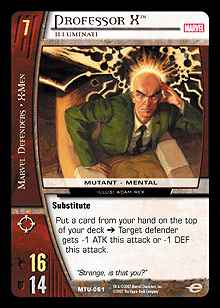 Professor X, Illuminati—Generally, when you have a strong, rare option at 7 resources, the other option is not nearly worth his salt. Well, UDE clearly wanted to mix it up, because Professor X could be better than Hulk, Strongest One There Is. Granted, his power is limited to the cards you have in your hand, but you’ll often have a few dead cards you wouldn’t mind pitching to his power. Suppose you draw your 2-drop and 3-drop on turn 7. I guess you could plan to lay them next turn, but why not turn them into something that could help you win the game? That is what Professor X does for you, and that is enough to warrant consideration for any deck—not just Marvel Defenders.
Professor X, Illuminati—Generally, when you have a strong, rare option at 7 resources, the other option is not nearly worth his salt. Well, UDE clearly wanted to mix it up, because Professor X could be better than Hulk, Strongest One There Is. Granted, his power is limited to the cards you have in your hand, but you’ll often have a few dead cards you wouldn’t mind pitching to his power. Suppose you draw your 2-drop and 3-drop on turn 7. I guess you could plan to lay them next turn, but why not turn them into something that could help you win the game? That is what Professor X does for you, and that is enough to warrant consideration for any deck—not just Marvel Defenders.
8-drops
I have never been a big fan of 8-drops (though I was slightly amused that Jason Hager, en route to one of his many PC Top 8 appearances, played one and actually recruited it in a couple games). I don’t think you’ll be able to consistently make the game last until turn 8 with most decks, and even if you do reach turn 8, another 7-drop can perform basically the same functions as an 8-drop. Still, if there is one deck that could sport an 8-drop, I guess it would be a Marvel Defenders variant, as this team has more than enough defensive capabilities to enable you to survive until turn 8.
Dr. Strange, Sorcerer Supreme— Unfortunately, Dr. Strange, Sorcerer Supreme doesn’t do much for you in Sealed and Draft unless you happened to drop characters with backup powers earlier, or subbed them in before you recruited him. If his stats were a bit bigger, then I could see playing him in a defensive deck, but I have to say that there are better options available to you. I just don’t see myself playing this guy.
In the End
I hope you enjoyed the first part of the Marvel Team-Up Sealed / Draft review. I have to say that just writing this article has generated a lot of excitement and many deckbuilding concepts between my teammates and me. That's what's so great about the Sealed / Draft aspect of this game: Trying to improve is naturally leads to improvement in the other aspects. Check back next week when I go over the plot twists, locations, and equipment the Marvel Defenders have to offer. Until next time, take care!
Shane Wiggans, one of the nicest guys with a tattoo sleeve, is also a member of Team Alternate Win Condition and would like to officially welcome Ed Colleran and Billy Postlethwait to the T.A.W.C. team. If you have any questions or comments, feel free to say hey at any event or email him at piercedlawyer@yahoo.com.